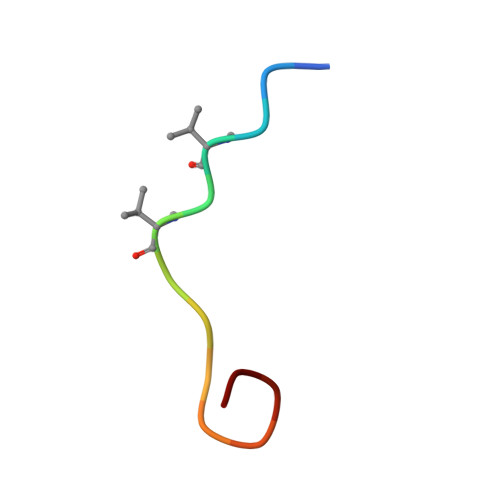Substrate Plasticity of a Fungal Peptide alpha-N-Methyltransferase.
Song, H., Fahrig-Kamarauskaite, J.R., Matabaro, E., Kaspar, H., Shirran, S.L., Zach, C., Pace, A., Stefanov, B.A., Naismith, J.H., Kunzler, M.(2020) ACS Chem Biol 15: 1901-1912
- PubMed: 32491837
- DOI: https://doi.org/10.1021/acschembio.0c00237
- Primary Citation of Related Structures:
6QZY, 6QZZ, 6R00, 6TSC - PubMed Abstract:
The methylation of amide nitrogen atoms can improve the stability, oral availability, and cell permeability of peptide therapeutics. Chemical N -methylation of peptides is challenging. Omphalotin A is a ribosomally synthesized, macrocylic dodecapeptide with nine backbone N -methylations. The fungal natural product is derived from the precursor protein, OphMA, harboring both the core peptide and a SAM-dependent peptide α- N -methyltransferase domain. OphMA forms a homodimer and its α- N -methyltransferase domain installs the methyl groups in trans on the hydrophobic core dodecapeptide and some additional C-terminal residues of the protomers. These post-translational backbone N -methylations occur in a processive manner from the N- to the C-terminus of the peptide substrate. We demonstrate that OphMA can methylate polar, aromatic, and charged residues when these are introduced into the core peptide. Some of these amino acids alter the efficiency and pattern of methylation. Proline, depending on its sequence context, can act as a tunable stop signal. Crystal structures of OphMA variants have allowed rationalization of these observations. Our results hint at the potential to control this fungal α- N -methyltransferase for biotechnological applications.
Organizational Affiliation:
Division of Structural Biology, Wellcome Trust Centre of Human Genomics, Roosevelt Drive, Oxford OX3 7BN, United Kingdom.

















